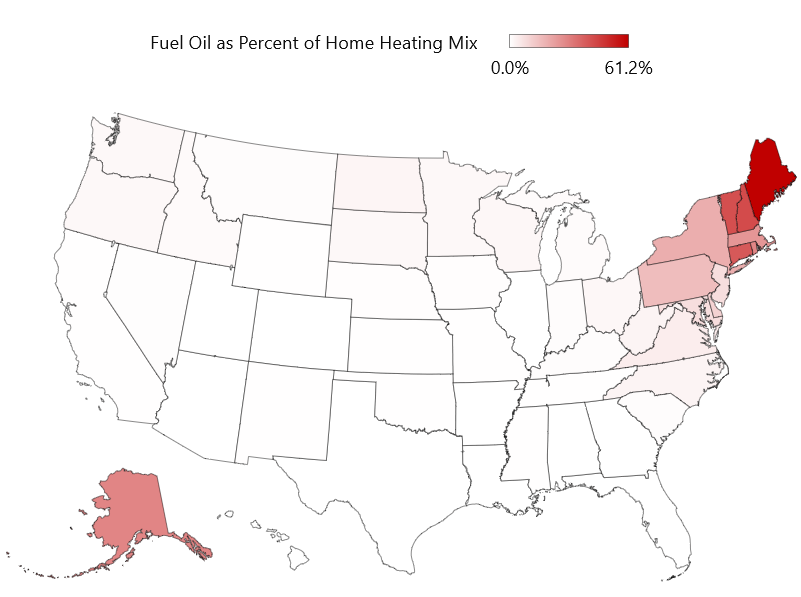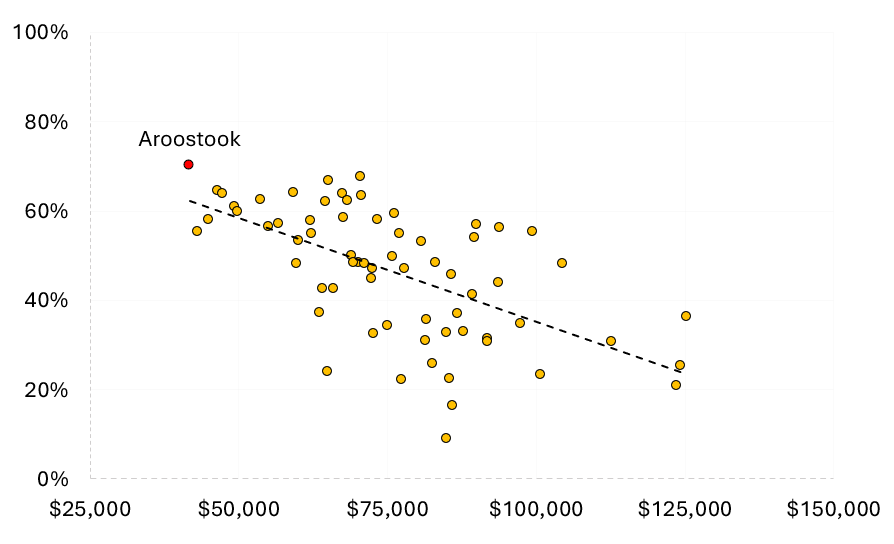
Fifty-nine percent of all U.S. households are still dependent on fossil fuels for primary space heating, according to the most recent 2020 Residential Energy Consumption Survey (RECS). Natural gas is the most prevalent space heating fuel in the United States, used in nearly 63 million households (51 percent). Home heating oil and propane account for another 5 million households (4 percent) each.
Propane and home heating oil are 19 and 40 percent more carbon-intense than natural gas, respectively. They are also the most expensive options for heating on a dollar-per-BTU basis alongside electric baseboard heating, according to analysis conducted by Atlas Public Policy. Thus, households using either propane or home heating oil for primary space heating should be the first targets for electrification projects, i.e., the installation of heat pumps and heat pump water heaters.
In this analysis, we examine the areas of the country most dependent on home heating oil and propane, the health and monetary impacts associated with both fuels, and available technologies to displace them.
Home Heating Oil
Home heating oil (often called fuel oil) is a petroleum product. Most home heating oil is No. 2 fuel oil, the same substance used by diesel trucks – though home heating oil is dyed red in the U.S. to distinguish it from diesel for tax reasons. Home heating oil is a heavy polluter; it emits nitrogen oxides (NOx), sulfur dioxide (SO2), particulate matter (PM), and carbon monoxide (CO). All four pollutants are known to cause and/or exacerbate respiratory illness.
Unlike natural gas or electricity, heating oil must be delivered by truck, which poses additional inconveniences and risks. For instance, homeowners must schedule deliveries in advance, and could risk losing access to space heating should extreme weather inhibit delivery. Furthermore, spills can contaminate soil and groundwater, and may even result in fires or explosions if the spill occurs indoors. Lastly, oil furnaces are susceptible to backfire or “puffbacks,” which occur when the appliance fails to ignite. When a backfire is severe enough, it can blast carcinogenic soot and smoke into the home, covering walls and furniture.
For these reasons, government actors, with the support of the private sector, should work to phase out fuel oil as quickly as possible.
Home Heating Oil: Regional Breakdown
The Northeast Census Region is home to 79 percent of all U.S. households dependent on fuel oil for space heating, per the 2020 RECS survey. Additionally, a staggering 91 percent of all households reliant on fuel oil for water heating are in the U.S. Northeast.
Figure 1: Percent of Households Using Fuel Oil/Kerosene for Primary Space Heating by State in 2020

Source: Buildings Hub Demographics Dashboard
Households located in the U.S. Northeast – primarily Maine, New Hampshire, Connecticut, and Vermont – often face high energy bills due to the price volatility of fuel oil. During this past November, the price per gallon for home heating oil reached all-time highs of $5.74 for the Mid-Atlantic (NY, NJ, and PA) and $5.50 for New England. Fuel oil prices in both sub-regions stood below $3.50 in November 2021; prices in 2022 witnessed a 67 percent per gallon increase year over year in New England and a 64 percent rise in the Mid-Atlantic. An increase of this magnitude is enough to put substantial strain on low- and middle-income households whose primary heating source is fuel oil.
To put this price spike into perspective, the average household with an oil boiler or furnace consumes seven gallons of heating oil per day when the outdoor temperature is 20°F. So, to heat the average New England home on a cold day, it would cost $38.50 if fuel was purchased in November 2022 (Atlas Public Policy).
Over the course of an entire month, a price jump like this can significantly increase a household’s energy burden, i.e., the percentage of their income devoted to energy expenditures.
Heating oil is expensive, and its use is especially prevalent in rural, lower-income counties in the Northeast. For instance, Aroostook County – Maine’s poorest county by median income – has the highest dependency on fuel oil for space heating in the whole state (and New England), at 70 percent of all county households. Conversely, Maine’s wealthiest county, Cumberland, has the lowest dependency on fuel oil in the state at 53 percent. County-level data is surfaced on the Buildings Hub Market Factors dashboard and comes courtesy of the 2020 American Community Survey.
Figure 2: New England 12-Month Median Household Income by County vs. Percent of Households Using Fuel Oil for Primary Space Heating

Source: Buildings Hub Demographics Dashboard
Figure 2 illustrates that – on average – the poorer the county is, the more it relies on No. 2 fuel oil to stay warm. This moderately strong negative correlation may be attributed in part to the lack of natural gas infrastructure in New England, especially in rural areas which tend to have lower median incomes.
Propane
Propane – a.k.a., liquified petroleum gas – is a fossil fuel stored within a pressurized tank. Like home heating oil, this fuel releases NOx, SO2, and PM when combusted. Furthermore, the use of propane indoors carries the risk of carbon monoxide poisoning if not properly ventilated.
Together, the U.S. South and Midwest are home to more than two-thirds of all households dependent on propane for primary space heating, according to the 2020 RECS.
Figure 3: Percent of Households Using Propane for Primary Space Heating by State in 2020

Source: Buildings Hub Demographics Dashboard
The state with the greatest number of propane-dependent homes is California, although this is mainly a factor of population. Only 3.38 percent of Golden State households utilize propane for primary space heating.
From a home heating-mix standpoint, the Northeast dominates once again. About 17.5 and 16.9 percent of Vermont and New Hampshire households rely on propane for primary space heating respectively—the highest shares in the nation. In fact, Vermont is the least electrified state in the country, with only 6 percent of households equipped with primary electric space heating.
Not far behind in propane dependence are the Midwestern states: North Dakota, South Dakota, and Iowa. More than 13 percent of households rely on propane for primary space heating in all three states.
Alaska: A Unique Case
Of the ten states most reliant on home heating oil, the only one not located in the Northeast is Alaska. Nearly one-third of Alaskan households rely on oil to stay warm. However, unlike the Northeastern states, Alaska consumes negligible amounts of propane, and is instead reliant on piped natural gas like so much of the United States.
Some Alaskans living away from the state’s primary grid also experience exorbitant electricity prices, which can limit the adoption of cleaner heating methods.
American Indians and Alaska Natives (AI/NA) in the state are particularly reliant on fuel oil for space heating (37 percent of households versus 23 percent for White households). Notably, AI/NA households also rely on wood and wood pellets for 13 percent of their space heating needs, as opposed to only 3 percent of White households.
Figure 4: Primary Space Heating Fuel by Household Race in Alaska (2020)

Source: 2020 Residential Energy Consumption Survey
Fortunately, microgrids are proliferating across AI/NI communities in Alaska. This technology will help ameliorate energy burdens for indigenous communities and provide access to cheaper electricity, and thus, cleaner heating.
Factors Hindering Electrification
It’s easy to spot a common trend between states most reliant on the dirtiest fuels: cold climate and expensive electricity. Most counties within Alaska and the Northeast fall under Climate Zones 6 or 7, warmer only than Zone 8, which is classified as Subarctic/Arctic. Additionally, electricity prices in these states are often double or triple that of the South or Midwest, according to Building Hub.
In decades past, heat pumps were seen as unreliable in these climate zones, where temperatures often drop well below freezing. However, modern cold climate air-source heat pumps (ccASHPs) can now outperform their fossil-fueled counterparts in temperatures as low as –5°F. Recent studies conducted in Maine and Alaska demonstrate that cold-climate electric heating is absolutely possible, and it will likely save consumers money in the long term.
State and Utility Funding Programs and Rebates
Myriad programs exist to boost heat pump adoption in New England, and to a lesser extent, in the Midwest. For instance, Maine passed LD 1766 in 2019, which committed the state to installing 100,000 residential air-source heat pumps (ASHPs) in the state by 2025. To achieve this goal, the Efficiency Maine Trust offers $2,000 for income-qualified Mainers to install an ASHP.
Similarly, Energize Connecticut provides thousands of dollars in rebates for heat pumps and heat pump water heaters, along with insulation to make both appliances even more efficient.
Millions of households still rely on dirty and dangerous fuels like fuel oil and propane for space and water heating. However, the combination of incentive programs and technological advancements will enable many of them to pivot to electricity, mitigating emissions and health impacts alike and saving money in the process.



